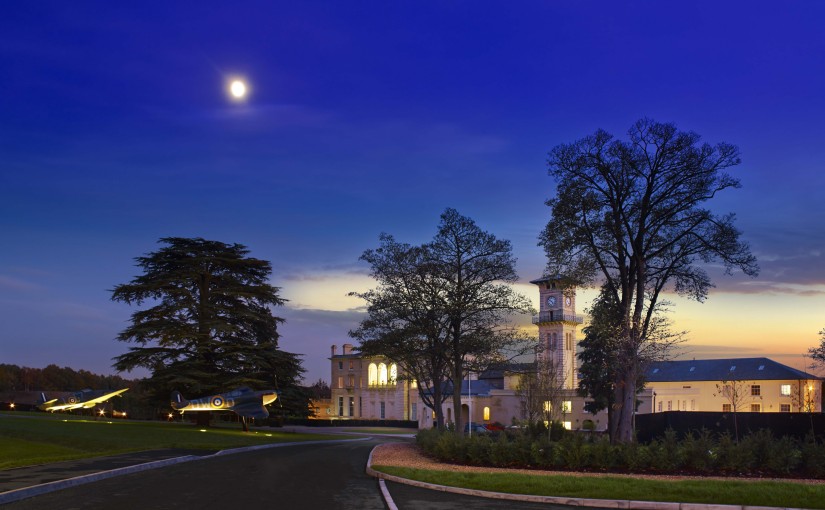Bentley Priory and The Battle of Britain, 1940
Bentley Priory is best known for its pivotal role as Headquarters Fighter Command during the Battle of Britain in 1940.
Before the Air Ministry bought Bentley Priory in 1926, it had been a private home, hotel and girls’ school.
Origins of Bentley
The name Bentley is believed to mean land artificially cleared of coarse grass for pasture or cultivation.
Bentley Priory: Priory & Dissolution
Bentley Priory was once a Priory, home to a cell of Augustinian Friars. It is believed that the Priory was founded in 1170 by Ranulf de Glanville, who became Chief Justiciary of England.
During the dissolution of the monasteries in the 1500s, Bentley Priory ceased to be a priory and the land changed hands on numerous occasions, including brief ownership by King Henry VIII.
Duberly & Development
In 1766 the estate was sold to James Duberly. Duberly pulled down the original Priory and built the first part of the present Bentley Priory, on the highest point on the ridge some distance from the original site.
Bentley Priory and The Marquess of Abercorn
 In 1788, Bentley Priory was sold to John James Hamilton, the 9th Earl of Abercorn, who became the 1st Marquess of Abercorn in 1789.
In 1788, Bentley Priory was sold to John James Hamilton, the 9th Earl of Abercorn, who became the 1st Marquess of Abercorn in 1789.
The Marquess of Abercorn was one of the only men to hold peerage titles in England, Scotland and Ireland. During his ownership, Bentley Priory was a social and political hub. Visitors included politicians Pitt, Canning and Lord Liverpool and poets Wordsworth and Sir Walter Scott.
Bentley Priory and Sir John Soane
In 1788, The Marquess of Abercorn commissioned architect Sir John Soane to extend and refurbish Bentley Priory in ‘a more lavish and sumptous manner’. Best known for his design of the Bank of England, Sir John Soane specialised in neo-classical architecture and clever designs which encouraged natural light into rooms and buildings. Soane’s additions to Bentley Priory include the stained glass windows in the Entrance Hall and the spectacular Rotunda.
Bentley Priory as a Royal Residence
Dowager Queen Adelaide, the aunt of Queen Victoria, lived at Bentley Priory during the last year of her life, 1848-1849. The spectacular ceiling in the ‘Queen Adelaide’ room at Bentley Priory was restored as part of the creation of the Museum.
Bentley Priory: Private Home, Hotel & Girls’ School
 After Queen Adelaide’s death, the estate was sold to Sir John Kelk, noted civil & railway engineer. He added a picture gallery, conservatories, the clocktower and commisioned the creation of the Italian Gardens, which have been restored and are accessible to Museum visitors.
After Queen Adelaide’s death, the estate was sold to Sir John Kelk, noted civil & railway engineer. He added a picture gallery, conservatories, the clocktower and commisioned the creation of the Italian Gardens, which have been restored and are accessible to Museum visitors.
The estate was sold in 1882 to Frederick Gordon, of Gordon Hotels, who converted Bentley Priory into a hotel. Despite spending £48,000 to extend the Railway Line from Harrow to Stanmore to attract guests, the hotel was not a success.
In 1908, the hotel was sold and Bentley Priory became a Girl’s School, home to 70 boarders. In the early 1920s, the school closed and Bentley Priory stood empty for a few years until 1926.
Bentley Priory and the RAF
In 1926, the Priory estate was split up and one lot comprising of the Priory itself and around 40 acres was sold to the Air Ministry, for a sum believed to be £25,000. In May 1926, Inland Area (Training Command), part of the Air Defence of Great Britain (ADGB) moved into the Priory. As the RAF grew in size, the ADGB was dissolved and Bomber, Coastal, Fighter and Training Commands were created.
In July 1936, RAF Fighter Command was created and moved into Bentley Priory. Air Chief Marshal Sir Hugh Dowding became its first Commander-in-Chief.
Fighter Command amalgamated with Bomber Command in 1968, to form Strike Command and Bentley Priory became an administrative and training unit.
The RAF were Bentley Priory’s longest serving residents, occupying the Mansion House and grounds until they departed in 2008.
Bentley Priory Museum
Bentley Priory Museum opened in 2013, after 8 years of planning and fundraising.
 What’s On
What’s On Opening Hours & Admission
Opening Hours & Admission


